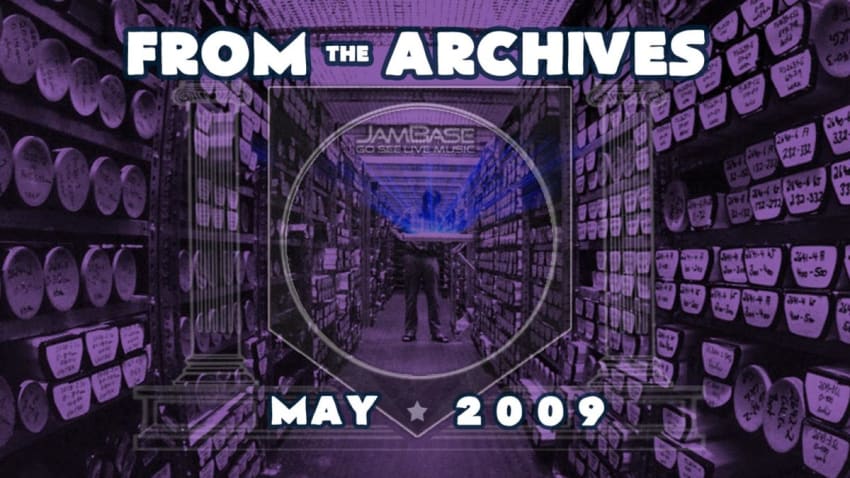Sun Spin:Siouxsie and the Banshees
By Team JamBase May 31, 2009 • 4:48 pm PDT

THAT’S STOOD THE TEST OF TIME DESPITE SOME TRULY REGRETTABLE FASHION CHOICES
 |
Hear our hearts bell a serenade
A faint choir tenderly shaping
A lament…a hollow refuge
As critics ululate the charms of Karen O (Yeah Yeah Yeahs) and Alison Mosshart (The Kills, The Dead Weather) they frequently gloss over an essential ancestor to these punk-sanded, new millennial divas – Siouxsie Sioux, leader and lightning rod of one of the under-sung influences on modern rock, Siouxsie and the Banshees. With lyrics like something out of the Bloomsbury Group, a ragged, apocalyptic demeanor and a jittery, experimental musical bent woven into an obvious descendent of Revolver-era Beatles, the Banshees quickly carved a chunk out of the pop culture psyche with their 1978 debut, The Scream, onwards. Menacing, primal and consciously arty, the band piled up critically acclaimed albums, each putting new layers of skin on their monster, adding curious angles and demolishing old ones in an always-forward rush. In many respects, the group neatly picks up the baton the Patti Smith Group laid down in 1979, running fast with Smith’s tough, feminist, ballsy form of rock exploration.
Always a bit of a thing in England and Europe, Siouxsie and the Banshees didn’t emerge from cult status in the U.S. until the late 1980s. Yet, like Smith and her Group, the band found greater public awareness and commercial success just as their snarly beginnings started to mutate into something sleeker with more polished surfaces but still inky deep below them. While 1986’s Tinderbox swelled their cult to theatre audience size stateside, it was their inspired cover tune collection, Through The Looking Glass, the next year that put them on fledgling “alternate rock” radio and established their first serious toehold on MTV.
Always a powerhouse singer, Siouxsie reaches full flower on Looking Glass, where she unflinchingly takes on heavyweights like Billie Holiday (“Strange Fruit”), Jim Morrison (“You’re Lost Little Girl”), Bryan Ferry (Roxy Music’s “Sea Breeze”) and Iggy Pop (“The Passenger”). In every instance, she puts her own stamp on the material and exhibits individuality and imagination that compares well with her source inspirations. Gone are most of the affectations and tics that garnered attention in her early work, tamed and targeted with a pro’s control as she breathes life into Disney (The Jungle Book‘s “Trust In Me”), Dylan (“This Wheel’s On Fire”), John Cale (“Gun”) and Sparks (“This Town Ain’t Big Enough For The Both of Us”).
The band – Steve Severin (bass, keys), Sioux’s spouse Budgie (drums, percussion), John Carruthers (guitars) and Martin McCarrick (cello, keys, string arrangements) – is similarly hellbent on tackling the songs with far more gusto than one typically encounters on covers sets. They walk a fine line between orthodox treatments and wholesale reinvention, but always play with open passion and serious solidity. Though Carruthers would depart before the follow-up, the groundwork, through the pathway of their inspirations, had been laid for the Banshees’ finest album.
 |
Coming after eight years of Reagan and Thatcher, Peepshow is reflective of a harder, colder world full of slogans but little empathy, a worldview full of absolutes and white and black cowboy hats. Siouxsie and the boys peel away the surfaces of this tidy scheme o’ things to reveal embittered strippers crying dry tears with a flaccid ego in their hand, ardent arsonists, scarecrows dreaming of gold and silver, hidden dreams turned to stone. It’s an uncomfortable mirror but shiny enough that at first we don’t recognize that it’s our reflection in the glass, then recoiling as we mutter, “That really must be someone else.” Written in a genuinely poetic language and splashed with non-radio friendly elements like accordion and cello, Peepshow is a late 20th Century Grand-Guignol presented in plain view instead of tucked down some Parisian alleyway.
The singles received high gloss videos and the corresponding world tour was an elaborate production befitting Peepshow‘s carnival o’ the strange atmosphere. Shows would generally open with the band assembled before a curtain, vaudeville-era style, decked out in silk top hats and Commedia dell’Arte masks, marching drums at the ready as they introduced a high concept evening far removed from your average rock show with the simmering, romantic quiver of “The Last Beat of My Heart” (a song now covered by Devotchka, one of numerous offspring that borrow some of their DNA). From the stuttering striptease of “Peek-A-Boo” to the gasping death rattle of “The Killing Jar” to the dissection of material escapism in “Ornaments of Gold,” Peepshow took stock of the times and did what great art should – made something relevant beyond the moment. Between the opulent concert staging and pricey videos, the whole package reeked of late ’80s hedonism but was really a Trojan horse containing the undoing of the empty hearted opulence it seemed to revel in.
Through The Looking Glass Track Listing
1. “This Town Ain’t Big Enough for Both of Us” (original by Sparks)
2. “Hall of Mirrors” (original by Kraftwerk)
3. “Trust in Me” (original in The Jungle Book movie)
4. “This Wheel’s on Fire” (written by Rick Danko/Bob Dylan; based on version by Julie Driscoll)
5. “Strange Fruit” (original by Billie Holiday)
6. “You’re Lost Little Girl” (original by The Doors)
7. “The Passenger” (original by Iggy Pop)
8. “Gun” (original by John Cale)
9. “Sea Breezes” (original by Roxy Music)
10 “Little Johnny Jewel” (original by Television)
Peepshow Track Listing
1. “Peek-a-Boo”
2. “The Killing Jar”
3. “Scarecrow”
4. “Carousel”
5. “Burn-Up”
6. “Ornaments of Gold”
7. “Turn to Stone”
8. “Rawhead and Bloodybones”
9. “The Last Beat of My Heart”
10. “Rhapsody”
Short MTV interview from 1988
